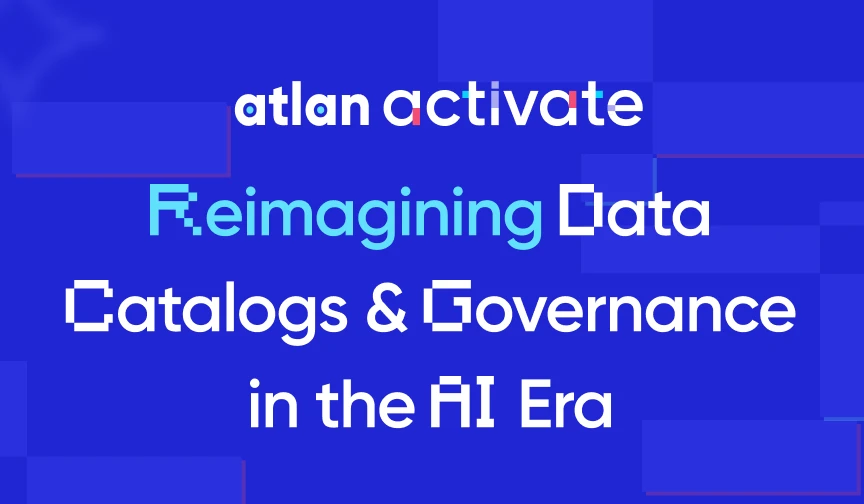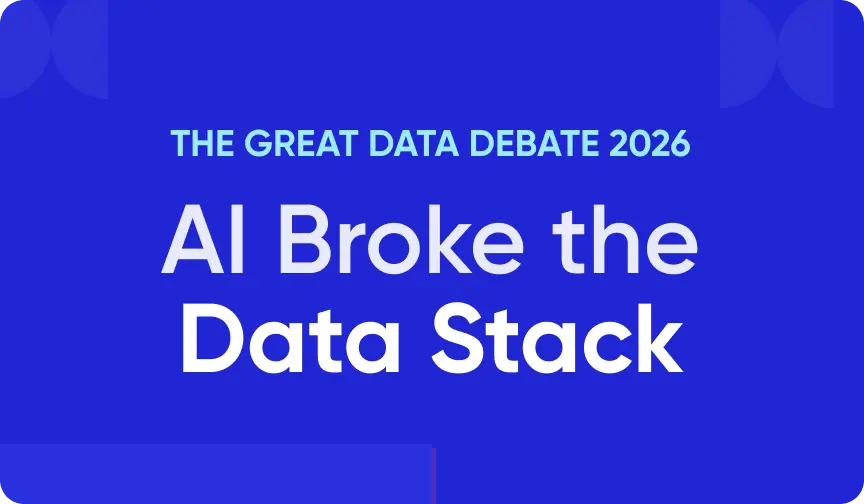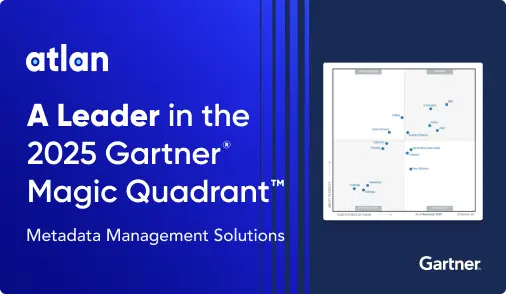Data Quality Management Software: What To Look For in 2025

Last Updated on: July 03rd, 2025 | 9 min read
Unlock Your Data's Potential With Atlan

Quick Answer: What is data quality management software?
Permalink to “Quick Answer: What is data quality management software?”Data quality management software is a category of tools that help organizations assess, improve, and maintain the reliability of their data across systems. By embedding quality checks into daily workflows and tying them to ownership and business context, it turns data quality from a one-off task into a continuous and shared operational process.
So, how do you select the right data quality management software, picking the right option in a crowded market?
This article lists the basic capabilities to evaluate a data quality management software platform. We’ll also explore the role of a unified quality trust engine like Atlan in improving data quality at scale.
Table of contents
Permalink to “Table of contents”- What is the state of the data quality management software in 2025?
- How can you evaluate data quality management software in 2025? 5 essential aspects to consider
- Data quality management software: How Atlan’s Data Quality Studio supports quality at scale
- Final thoughts on data quality management software in 2025
- Data quality management software: Frequently asked questions (FAQs)
What is the state of the data quality management software in 2025?
Permalink to “What is the state of the data quality management software in 2025?”Summarize and analyze this article with 👉 🔮 Google AI Mode or 💬 ChatGPT or 🔍 Perplexity or 🤖 Claude or 🐦 Grok (X) .
According to Gartner, poor data quality costs organizations an average of $12.9 million annually. And in the 2024 Gartner AI Mandates for the Enterprise Survey, data availability and quality were reported as top barriers to AI adoption, with only 40% of AI prototypes making it into production.
As a result, Gartner predicts that by 2027, 70% of organizations will implement modern data quality solutions to support AI and digital business initiatives. Gartner also highlights a fundamental shift in how these solutions approach solving data quality issues – using active metadata, AI, and graph technologies.
Such modern data quality management solutions:
- Bring automation to profiling, monitoring, and rule enforcement
- Enrich context using metadata
- Track lineage, and conduct root cause as well as impact analysis
As AI adoption evolves, handling unstructured data is becoming an essential requirement, since D&A leaders are interested in using unstructured data for RAG. Preparing data for RAG pipelines and fine-tuning use cases requires fit-for-purpose data.
Why data quality management software needs a control plane
Permalink to “Why data quality management software needs a control plane”It is also important to look for data quality management software that isn’t a standalone platform, but instead is part of a broader set of data management processes like data governance, cataloging, integration, and more.
That’s because most teams solving data quality problems generally start small, with scripts, open-source tools, or observability add-ons. Then they add alerting, visualization, and catalogs on top.
This fragmentation slows everyone down. Rules are duplicated. Metadata is siloed. Quality alerts are noisy and disconnected from business context. And when dashboards break, the triage starts from scratch.
Additionally, over time, these tools become difficult to manage and ensuring their interoperability with the rest of your data stack becomes challenging.
Modern data quality management requires a unified control plane that connects metadata, ownership, rules, lineage, and collaboration—so quality can be embedded across workflows, not managed in isolation.
Also, read → Why isn’t AI delivering value yet?
How can you evaluate data quality management software in 2025? 5 essential aspects to consider
Permalink to “How can you evaluate data quality management software in 2025? 5 essential aspects to consider”Your ideal platform depends on your stack, your teams, and your goals. But there are five core areas to evaluate across any platform:
- Data quality rule creation and enforcement
- Metadata and lineage
- Data quality monitoring and observability
- Issue triage and resolution
- Focus on business workflows and use cases
1. Data quality rule creation and enforcement
Permalink to “1. Data quality rule creation and enforcement”Start with defining what “quality” means in your context. Your software should allow you to build reusable rules that can be automatically applied across systems, domains, or tags like “PII” or “restricted”.
Look for capabilities, such as:
- No-code and SQL-based rule creation
- Smart scheduling (cron, on-demand, or on data arrival)
- Versioned rules with audit trails
- Rule-to-asset mapping and metadata-based propagation
2. Metadata and lineage
Permalink to “2. Metadata and lineage”Context is everything. Metadata tells you what a dataset represents, who owns it, where it came from, and how it connects to other systems.
Look for capabilities, such as:
- End-to-end column-level lineage across sources, transformations, and outputs
- Integration with business glossaries and classification frameworks
- Tag-based rule automation (e.g., masking sensitive fields)
- Change impact reports for schema or rule updates
- Active metadata ingestion and sync with catalogs, warehouses, monitoring tools, orchestration tools, and more
3. Data quality monitoring and observability
Permalink to “3. Data quality monitoring and observability”Visibility into data health is essential for managing trust. Your software should provide continuous, low-maintenance monitoring across formats and systems.
Look for capabilities, such as:
- Built-in profiling for structured and unstructured data
- Auto-scheduled checks (freshness, schema drift, nulls, outliers)
- Real-time alerts tied to assets and owners
- Reporting dashboards showing data quality coverage and trends, issue frequency, etc. at a glance
- API/webhook support to route alerts into Slack, Jira, or other systems
4. Issue triage and resolution
Permalink to “4. Issue triage and resolution”Even with automation, humans need to investigate and fix issues. Platforms should support collaboration and integrate with your daily workflows.
Look for data quality management software capabilities, such as:
- Embedded collaboration with Slack, Jira, or communication and ticketing tools
- Embedded ownership and role-based permissions
- Contextual enrichment with lineage, tags, related issues
- Status tracking, comments, and tagging within the platform
- Central dashboard to view open, resolved, and escalated issues
5. Focus on business workflows and use cases
Permalink to “5. Focus on business workflows and use cases”If only engineers can use the platform, quality won’t scale. Look for software that’s accessible to business, governance, and domain teams.
This would include capabilities, such as:
- No-code rule builders
- Role-based dashboards for business and technical users
- Data trust indicators (freshness, popularity, ownership)
- Visualization of quality trends and business impact
- Support for data contracts to formalize expectations
- Interoperability with BI tools and technical catalogs
With these factors in mind, let’s look at how Atlan’s Data Quality Studio brings your entire data ecosystem together to support AI-readiness across the stack.
Data quality management software: How Atlan’s Data Quality Studio supports quality at scale
Permalink to “Data quality management software: How Atlan’s Data Quality Studio supports quality at scale”Atlan’s Data Quality Studio acts as a control plane that brings together metadata, quality rules, lineage, and collaboration. It integrates with your stack — Snowflake, Databricks, Monte Carlo, Soda, Great Expectations — to centralize monitoring and enforcement.
Let’s walk through the evaluation factors from the previous section to see Atlan in action.
1. Data quality rule creation and enforcement
Permalink to “1. Data quality rule creation and enforcement”Atlan lets you define what good data looks like and ensures rules are enforced consistently through automation and metadata tagging across domains.
Key capabilities include:
- No-code rule builder and SQL editor for flexible test creation
- Smart scheduling to run tests on cron, on-demand, or when fresh data arrives
- Metadata-driven rule enforcement to automatically add and propagate tags like “PII” or “restricted”
- Versioned rules with full audit history
- Rule-to-asset mapping through metadata
2. Metadata and lineage integration
Permalink to “2. Metadata and lineage integration”By connecting metadata and quality in one platform, Atlan helps teams assess root cause, enforce policies, and maintain audit readiness.
Key capabilities include:
- End-to-end column-level lineage for traceability
- Active metadata sync with catalogs, quality tools, and orchestration platforms
- Impact reports for schema and rule changes
- Tag-based policies linked to rules (e.g. auto-mask PII)
- Integration with glossary terms and business classifications
3. Data quality monitoring and observability
Permalink to “3. Data quality monitoring and observability”Atlan centralizes quality signals and connects them with metadata and ownership, so alerts don’t happen in isolation.
Key capabilities include:
- Centralized monitoring across Snowflake, Databricks, and other warehouse platforms
- Alerts linked directly to assets and owners
- Dashboards for issue trends, test coverage, and business impact
- Historical tracking of pass/fail status by domain or asset
- Compatibility with open-source data quality tools and monitoring tools like Great Expectations, Monte Carlo, and Soda
4. Issue triage and resolution
Permalink to “4. Issue triage and resolution”Atlan enables quality to be operational, not reactive. Ownership is embedded into daily tools, so issues don’t fall through the cracks.
Key capabilities include:
- Issue routing into Slack, Jira, and BI tools
- Ownership assignment for faster resolution
- Enriched context with asset details, lineage, and related issues
- Activity log and resolution status tracking
- Integration with existing data workflows, tools, and systems – metadata stores, MDM tools, BI platforms, ingestion pipelines, and more
5. Focus on business-driven workflows and use cases
Permalink to “5. Focus on business-driven workflows and use cases”Atlan helps teams communicate what quality means, and gives everyone a shared view of data reliability and usefulness. So, teams across data, business, and governance use the platform without friction.
Key capabilities include:
- Data trust signals, such as freshness, documentation, popularity
- Business-friendly dashboards and no-code rule builders
- Support for data contracts to formalize expectations
- Reporting Center for test coverage, issue history, and quality trends at a glance
- Role-based access and user views tailored by domain, persona, purpose
Final thoughts on data quality management software in 2025
Permalink to “Final thoughts on data quality management software in 2025”In 2025, data quality platforms serve as the trust layer for data-driven enterprises. They power AI readiness, prevent governance blind spots, and create shared accountability across the organization.
Rather than relying on manual checks and scattered tools, organizations now need software that integrates context, intelligence, and collaboration into every part of the data lifecycle.
If you’re scaling your AI strategy or struggling with fragmented quality workflows, it’s time to evaluate platforms that bring quality out of the shadows and into the core of how your data teams operate.
Data quality management software: Frequently asked questions (FAQs)
Permalink to “Data quality management software: Frequently asked questions (FAQs)”1. What is data quality management software used for?
Permalink to “1. What is data quality management software used for?”Data quality management software helps organizations monitor, assess, and improve the accuracy, consistency, completeness, and timeliness of data across systems.
2. How does data quality differ from data observability?
Permalink to “2. How does data quality differ from data observability?”Observability monitors system behavior and pipeline health. Data quality focuses on the data’s reliability and fitness for use.
3. Why should modern data quality management software be equipped for AI-readiness?
Permalink to “3. Why should modern data quality management software be equipped for AI-readiness?”AI requires well-documented, high-quality data. Quality tools prevent bad inputs from reaching models, improving predictions and reducing risk.
4. What role does metadata play in data quality management?
Permalink to “4. What role does metadata play in data quality management?”Metadata connects rules to business context. It drives automation, maps ownership, enables policy enforcement, and improves traceability.
5. How do I know if I’ve outgrown my current setup?
Permalink to “5. How do I know if I’ve outgrown my current setup?”If you’re managing too many tools, struggling with context, or slow to resolve issues, it’s time for a unified, collaborative quality platform.
Share this article
Atlan is the next-generation platform for data and AI governance. It is a control plane that stitches together a business's disparate data infrastructure, cataloging and enriching data with business context and security.
Data quality management software: Related reads
Permalink to “Data quality management software: Related reads”- Data Quality Explained: Causes, Detection, and Fixes
- Data Quality Framework: 9 Key Components & Best Practices for 2025
- Data Quality Measures: Best Practices to Implement
- Data Quality Dimensions: Do They Matter?
- Resolving Data Quality Issues in the Biggest Markets
- Data Quality Problems? 5 Ways to Fix Them
- Data Quality Metrics: Understand How to Monitor the Health of Your Data Estate
- 9 Components to Build the Best Data Quality Framework
- How To Improve Data Quality In 12 Actionable Steps
- Data Integrity vs Data Quality: Nah, They Aren’t Same!
- Gartner Magic Quadrant for Data Quality: Overview, Capabilities, Criteria
- Data Management 101: Four Things Every Human of Data Should Know
- Data Quality Testing: Examples, Techniques & Best Practices in 2025
- Top Takeaways from Gartner D&A Summit 2025: A 5-Minute Recap
- Gartner Magic Quadrant for Data Quality: 2025 Insights
- Data Readiness for AI: 4 Fundamental Factors to Consider
- Role of Metadata Management in Enterprise AI: Why It Matters
- Atlan Launches Data Quality Studio for Snowflake, Becoming the Unified Trust Engine for AI
- Atlan Launches Data Quality Studio for Databricks, Activating Trust for the AI-Native Era





















